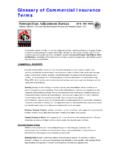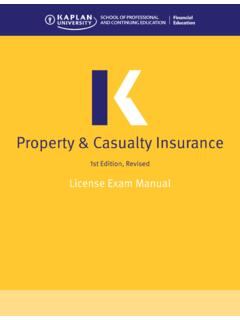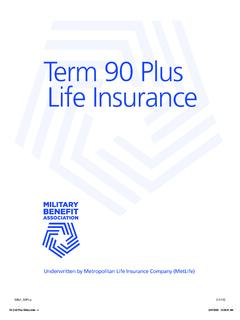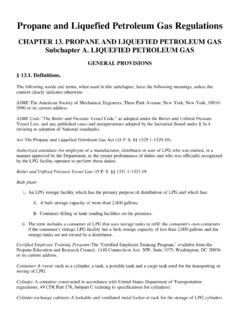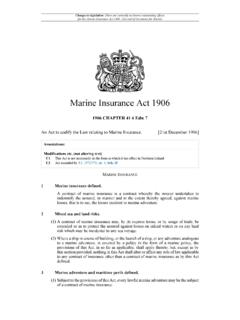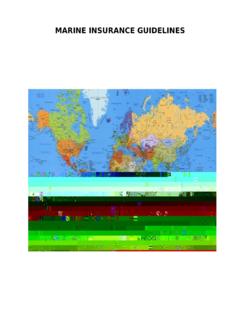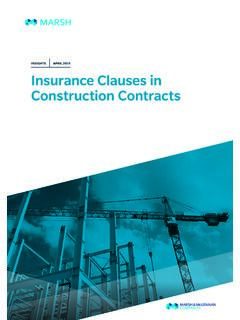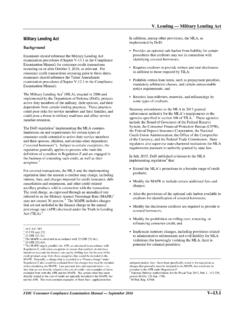Transcription of The Workboat Code - GOV.UK
1 The Workboat code Industry Working Group Technical Standard The Safety of Small workboats and Pilot Boats a code of Practice applicable to small workboats operating in commercial use to sea and all pilot boats. (The Merchant Shipping (Small workboats and Pilot Boats) Regulations 1998. (SI 1998/1609), as amended). Page 1. Note: This Technical Standard can, from the date of publication 1 June 2014, be used for new workboats and pilot boats as an equivalent construction standard to the requirements of The Safety of Small workboats and Pilot Boats A code of Practice , published by the Maritime and Coastguard Agency in 1998, in accordance with Regulation 8 of the Merchant Shipping (Small workboats and Pilot Boats) Regulations 1998 (SI1998/1609). Such vessels will continue to be issued with Certification under those regulations.
2 This Technical Standard is subject to final public consultation and scrutiny by the Department for Transport. Coded Vessel Safety Unit Vessel Standards Branch Maritime and Coastguard Agency Bay 2/25. Spring Place 105 Commercial Road Southampton SO15 1EG. Tel : +44 (0) 23 8032 9139. Fax : +44 (0) 23 8032 9104. e-mail: General Inquiries: MCA Website Address: File Ref: MS 183/01/23. Published: June 2014. Crown Copyright 2014. Safer Lives, Safer Ships, Cleaner Seas Page 2. Contents 1 FOREWORD .. 5. 2 Definitions .. 10. 3. Application and Interpretation .. 20. 4. Construction and Structural Strength .. 24. 5. Weathertight Integrity .. 31. 6 Water Freeing Arrangements .. 36. 7 Machinery .. 37. 8 Electrical Arrangements .. 42. 9 Steering Gear, Rudder and Propeller Systems .. 47. 10 Bilge Pumping .. 49. 11 Stability.
3 51. 12. Freeboard and Freeboard Marking .. 67. 13 Life-Saving 71. 14 Fire Safety .. 80. 15 Fire Appliances .. 86. 16. Radiocommunications Equipment .. 90. 17. Navigation Lights, Shapes and Sound Signals .. 94. 18 Navigational 97. 19 Miscellaneous Equipment .. 99. 20 Anchors and Cables .. 101. 21 Accommodation and Recreational Facilities .. 105. Accommodation and Recreational Facilities .. 108. 21B Accommodation and Recreational Facilities .. 114. 22. Protection of Personnel .. 116. 23. Medical Care .. 122. 24. Tenders and Daughter 123. 25. Requirements Specific to the Use of the Vessel .. 125. 26 Manning .. 145. 27. Procedures, Certification, Examination, Maintenance and Reporting of Accidents.. 154. 28 Prevention of Pollution .. 169. 29 Carriage and Transfer of Cargoes (including Dangerous Goods) .. 173. 30 Safety Management.
4 182. APPENDIX 1. GMDSS Sea Areas around the UK .. 183. APPENDIX 2. Maritime Labour Convention, 2006 Seafarer Employment 184. APPENDIX 3. The Manning of Small 192. APPENDIX 4. Equivalent Safety Standards for vessels operating in protected waters .. 202. APPENDIX 5. Liquid Petroleum Gas installation for domestic use .. 205. APPENDIX 6. Marine Pollution Prevention Information .. 209. Appendix 7. Safety Management System .. 215. Page 3. APPENDIX 8. Alternative Compliance Standards for RIBs .. 219. APPENDIX 9. Fire Test for FRP .. 221. APPENDIX 10. Ignitability Test for combustible material .. 222. APPENDIX 11. Stability Information Booklet Contents .. 224. APPENDIX 12. Use of ISO "First of Type" Righting Movement Curve .. 228. APPENDIX 13. STANDARDS APPENDIX .. 230. APPENDIX 14. Merchant Shipping Regulations that apply to Small workboats and Pilot Boats.
5 233. Appendix 15. Sample Certificates .. 238. Page 4. 1 FOREWORD. This code applies to small workboats that operate to sea, and to pilot boats of any size operating either at sea or in categorised (ie inland) waters. It applies to such vessels that are United Kingdom (UK) vessels wherever they may be, and to non- United Kingdom vessels in UK waters or operating from UK ports. The code applies to such vessels in commercial use, other than when in use for recreational, sport or pleasure use, for which there are more appropriate codes. The code is applied in accordance with the Merchant Shipping (Small workboats and Pilot Boats) Regulations 1998, SI1998/1609, as amended ( the enabling Regulations ). It is therefore applied as an equivalent standard to full compliance with Merchant Shipping regulations covering Load Line and other safety and operational matters, and operators have the right to comply in full with those other standards instead of this code .
6 However the National Workboat Association and other representatives on the Industry Working Group that developed this code consider that it will be easier to apply and understand a code of Practice than the many separate regulations that would otherwise have to be consulted and complied with. Vessels that comply with the code may additionally be issued with a UK Load Line Certificate. This second edition of the code amends the original code , The Safety of Small workboats and Pilot Boats A code of Practice introduced in 1998, and applies to small workboats and pilot boats, the keels of which are laid, or are at a similar stage of construction, on or after [1 January 2015]. This is defined in the Merchant Shipping Notice issued in accordance with the regulation 3(1) of the enabling regulations. From that date, this code supersedes the original code , and also the use of Marine Guidance Note MGN280 Small Commercial Vessels and Pilot Boat code of Practice for small workboats and pilot boats.
7 Small workboats are vessels of under 24m in Load Line length or, in the case of a vessel the keel of which was laid or was at a similar stage of construction before 21 st July 1968, of less than 150 gross registered tons (measured in accordance with the regulations in force at that time). The code applies to vessel carrying their crew and up to 12 passengers. Such ships are treated, by both UK and international law, as a type of cargo ship and the level of safety and protection for those on board particularly passengers and trainees is considered to be commensurate with the current expectations of the general public for such vessels. It should be noted, however, that the class of vessel ie passenger or non-passenger depends very much on the terms on which those persons forming the crew have been engaged and the duties they are performing.
8 Compliance with the code in no way obviates the need for vessels and/or skippers to comply with relevant bylaws made by either the local/navigation authority or the port/harbour authority for the area in which the vessel operates. Local authorities may, for instance, have powers to require vessels to have passenger liability and third-party insurance cover, and to set the level of that cover. Additionally, recognising that some vessels operate both at sea and on inland waterways, attention is drawn to the common approach to vessel safety adopted by the major UK Inland Navigation Authorities. Owners/managing agent(s) of such vessels should also comply with any applicable requirements of any relevant authority for the area of operation. It should also be noted Page 5. that local authorities may also have powers over the use of the foreshore and landing places, and to issue licenses for their use.
9 The code can be applied to any small vessel that comes within the limits of paragraphs and Section 25 provides specific requirements for particular uses. Seagoing police boats should be surveyed and certificated in accordance with the "Police Boat Codes, Amendment 3 (PBC 3)", the MCA's Marine Information Note MIN399 refers. This code applies to all UK Pilot Boats. There is no equivalent Merchant Shipping legislation. Independent rescue boats, when engaged in commercial use, may use the Rescue Boat code instead of this code , in accordance with the MCA's Marine Guidance Note MGN466. The code can also be used for barges, pontoons, and similar small vessels when under tow, as specified in Section 25. The following organisations participated in the Industry Working Group that drafted this code , under the co-ordination of the UK National Workboat Association: BMT Nigel Gee British Marine Federation British Sub-Aqua Club Bureau Veritas Canals and Rivers Trust DNV-GL.
10 International Institute of Marine Surveyors International Jack-Up Barge Owners Association Lloyd's Register Maritime and Coastguard Agency Mecal National Workboat Association Port of London Authority Professional Boatman's Association Royal Yachting Association Society of Consulting Marine Engineers and Ship Surveyors UK Maritime Pilot's Association Yacht Designers and Surveyors Association This code aims to provide, in a single document, all the information needed for the design, construction, engineering, electrical systems, hull systems, fire protection, and provision of fire-fighting, life-saving, navigation and radio equipment. It also deals with the equally important subject of manning and of the qualifications needed for the senior members of the crew. In addition, designers, builders, owners and repairers of vessels, as appropriate, will need to pay special regard to the intended area of operation and the weather and working conditions to which a vessel will be subjected when developing the design and selecting the materials and equipment to be used in its construction and maintenance.










